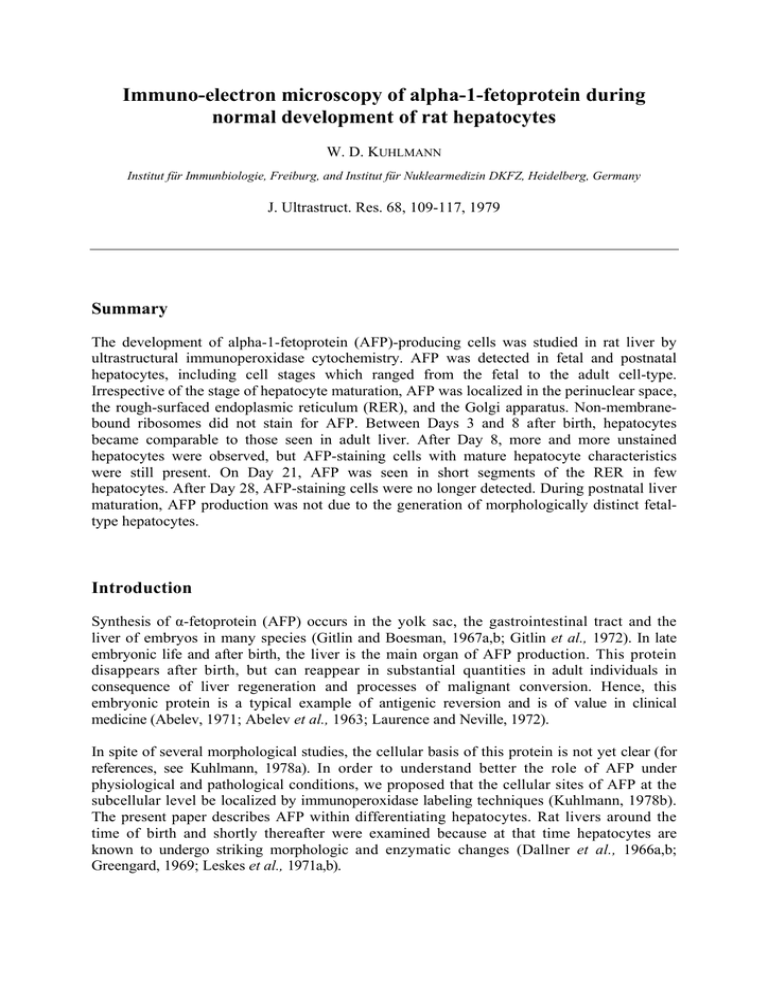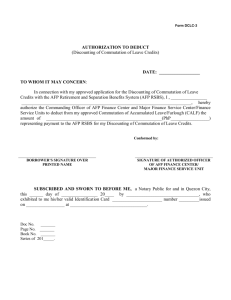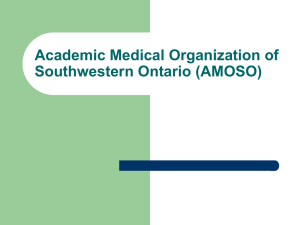Immuno-electron microscopy of alpha-1-fetoprotein during normal development of rat hepatocytes Summary
advertisement

Immuno-electron microscopy of alpha-1-fetoprotein during normal development of rat hepatocytes W. D. KUHLMANN Institut für Immunbiologie, Freiburg, and Institut für Nuklearmedizin DKFZ, Heidelberg, Germany J. Ultrastruct. Res. 68, 109-117, 1979 Summary The development of alpha-1-fetoprotein (AFP)-producing cells was studied in rat liver by ultrastructural immunoperoxidase cytochemistry. AFP was detected in fetal and postnatal hepatocytes, including cell stages which ranged from the fetal to the adult cell-type. Irrespective of the stage of hepatocyte maturation, AFP was localized in the perinuclear space, the rough-surfaced endoplasmic reticulum (RER), and the Golgi apparatus. Non-membranebound ribosomes did not stain for AFP. Between Days 3 and 8 after birth, hepatocytes became comparable to those seen in adult liver. After Day 8, more and more unstained hepatocytes were observed, but AFP-staining cells with mature hepatocyte characteristics were still present. On Day 21, AFP was seen in short segments of the RER in few hepatocytes. After Day 28, AFP-staining cells were no longer detected. During postnatal liver maturation, AFP production was not due to the generation of morphologically distinct fetaltype hepatocytes. Introduction Synthesis of α-fetoprotein (AFP) occurs in the yolk sac, the gastrointestinal tract and the liver of embryos in many species (Gitlin and Boesman, 1967a,b; Gitlin et al., 1972). In late embryonic life and after birth, the liver is the main organ of AFP production. This protein disappears after birth, but can reappear in substantial quantities in adult individuals in consequence of liver regeneration and processes of malignant conversion. Hence, this embryonic protein is a typical example of antigenic reversion and is of value in clinical medicine (Abelev, 1971; Abelev et al., 1963; Laurence and Neville, 1972). In spite of several morphological studies, the cellular basis of this protein is not yet clear (for references, see Kuhlmann, 1978a). In order to understand better the role of AFP under physiological and pathological conditions, we proposed that the cellular sites of AFP at the subcellular level be localized by immunoperoxidase labeling techniques (Kuhlmann, 1978b). The present paper describes AFP within differentiating hepatocytes. Rat livers around the time of birth and shortly thereafter were examined because at that time hepatocytes are known to undergo striking morphologic and enzymatic changes (Dallner et al., 1966a,b; Greengard, 1969; Leskes et al., 1971a,b). Material and Methods Animals and tissues. Inbred rats of strain BD-X were used. Fetal livers were taken from embryos of gestational Days 18, 20, and 22. The morning of vaginal plug detection after one overnight mating period was counted as Day 0 of gestation. Postnatal livers were dissected out of overnight-starved rats: 24 hr, 3, 5, 8, 14, 21, 28 days, and 3 months after birth. Immunological reagents. Anti-rat AFP immune sera were obtained by hyperimmunization of rabbits with isolated rat AFP. This was prepared by analogous procedures described for the isolation of mouse AFP (Kuhlmann, 1975). Antibodies were isolated from whole immune sera by use of immunoadsorbents; then IgG molecules were conjugated with horseradish peroxidase (HRP, RZ-3; Boehringer-Mannheim, Germany) and purified on a Sephadex G-200 column (Kuhlmann, 1977). In parallel to HRP conjugates of 7 S antibodies, Fab fragments were also isolated (Porter, 1959) and conjugated with HRP in a two-step procedure (Kuhlmann et al, 1974). For immunocytochemical controls HRP conjugates of normal rabbit IgG globulins and HRP conjugates of rabbit antiglucose oxidase antibodies were prepared in the same manner. Furthermore, peroxidase-labeled anti-AFP antibodies were absorbed with an immunoadsorbent which was prepared by coupling AFP to cyanogen bromide-activated Sepharose 4B (Cuatrecasas, 1970) as described by Kuhlmann (1978a). AFP content in sera of fetal and postnatal rats was quantitated by electroimmunodiffusion (Laurell, 1966) after which immune precipitates were visualized by incubation with sheep antirabbit IgG antibodies being conjugated with glucose oxidase (Kuhlmann, 1978a). Protein determinations were made with the Folin-phenol reagent (Lowry et al., 1951) using bovine serum albumin as standard. Tissue fixation and processing. The following procedures for tissue conservation and for immunocytochemical reactions were adopted after a study to define their optimal conditions (Kuhlmann, 1978b). Formaldehyde freshly prepared from paraformaldehyde and vacuumdistilled glutaraldehyde (purification index of PI = 0.1 to 0.2) were used in cacodylate-HCl buffer, pH 7.2 (0.2 mole sodium cacodylate/liter buffer). Fixation was carried out at 0°C with continuous agitation. The livers were sliced with razor blades into cubes of approximately 2 mm3 in a drop of ice-cold fixative and fixed in 6% formaldehyde for 5 hr, followed by 6% formaldehyde plus 0.25% glutaraldehyde for 90 min. After fixation tissue blocks were washed at 0°C for 18 hr with frequent changes of the buffer solution. Prior to treatment with peroxidase conjugates, the tissues were soaked with 10% dimethylsulfoxide, rapidly frozen in liquid nitrogen-cooled isopentane, and cut at 40 µm in a DittesDuspiva cryostat (Kuhlmann and Miller, 1971). Immunocytochemical procedures. All reactions were carried out at laboratory temperature. Tissue sections were floated in conjugates (0.5 mg/ml cacodylate buffer) for 2 hr, then rinsed three times in buffer followed by three washings of 10 min each. Peroxidase activity was revealed by incubation in 3,3'-diaminobenzidine (Graham and Karnovsky, 1966), 0.5 mg per 1 ml Tris-HCl buffer, pH 7.2 (0.2 mole Tris/liter buffer), containing 0.01% hydrogen peroxide. After washings in cacodylate buffer, the preparations were postfixed for 30 min in cacodylate-buffered 1% OsO4. The specificity of reactions was examined on tissues incubated in (1) normal rabbit IgG globulins labeled with HRP; (2) rabbit antiglucose oxidase antibodies labeled with HRP; (3) conjugates of rabbit anti-AFP antibodies being absorbed with an immunoadsorbent of rat AFP. Tissue sections were also treated with 1 or 2% H2O2/ml cacodylate buffer for 1-2 hr prior to incubation in order to abolish endogenous peroxidase activities in liver cells (Kuhlmann, 1975). All procedures were followed by Graham and Karnovsky's (1966) enzyme substrate. Electron microscopy. After postfixation tissue preparations were dehydrated in ascending ethanol series and flat embedded in Epon (Luft, 1961). Ultrathin sections were prepared (Reichert 0mU3) and mounted on Formvar-coated 200-mesh copper grids. Ultrathin sections were examined either unstained or after brief staining with lead citrate (Reynolds, 1963) for 3060 sec in a Siemens Elmiskop IA operating at 80 kV and with a 50-µm objective aperture. Results Immunocytochemical Reagents and Controls Qualitative and quantitative data on preparation of anti-AFP immune sera, isolation of specific antibodies, and their conjugation with peroxidase were already described (Kuhlmann, 1975, 1977, 1978a). For the detection of intracellular AFP, no difference in staining capacity of HRP conjugates from 7 S antibodies or Fab fragments were observed in the present material. Tissues did not stain upon incubation in HRP conjugates of either normal rabbit IgG globulins, or rabbit antiglucose oxidase antibodies, or absorbed rabbit anti-AFP antibodies. Endogenous peroxidases in postnatal liver cells were inhibited by treatment of sections with 1% hydrogen peroxide prior to incubation in immunocytochemical reagents. However, complete inhibition of the strong endogenous peroxidase activities in cells of the erythropoietic series in fetal liver was only attained with 2% H2O2/2 hr; endogenous peroxidases in granules of myeloblasts and myelocytes (granulopoietic series) partly resisted this treatment. Higher concentrations of H2O2 or other procedures for inhibition of endogenous peroxidases were not further investigated because the AFP label in hepatocytes was easily distinguished by fine-structural criteria. Localization of AFP in Fetal Liver At embryonic Days 18 and 20, hepatocytes were small in size, irregularly shaped, and constituted a network with adjacent hepatocytes. Nuclei were round to oval-shaped without invaginations and contained one or two nucleoli in the dense nucleoplasm. Within the network, erythropoietic cells were disseminated. The latter did not stain for AFP. At this stage of fetal development, hepatocytes contained variable amounts of rough-surfaced endoplasmic reticulum (RER) with randomly distributed lamellae. Almost all RER channels stained for AFP. However, in a few instances labeled and unlabeled lamellae were also seen concomitantly within the same cell (Figs. 1 and 2). In all AFP-staining cells, the perinuclear space (PNS) was stained, too. The small Golgi apparatus also contained the specific reaction product. From those fetal hepatocytes, less developed cells with blastoid appearance of still unknown origin and fate could be distinguished. These cells possessed a high nucleus-cytoplasm ratio. The cytoplasm contained many free ribosomes and only very few flat RER lamellae. In the dense nucleus, one enlarged nucleolus was discerned. In such cell stages no AFP could be detected (Fig. 2b). FIG. 1. Detection of AFP in RER lamellae (←) and PNS (◄) of fetal hepatocyte. Nucleolus (Nc). Lead citrate counterstain. Gestational Day 18. x 17500. Fig. 2. Localization of AFP in fetal liver, lead citrate counterstain. (a) Gestational Day 20; segments of the PNS (◄) are stained, and labeled (←) as well as unlabeled RER lamellae are seen; note staining of AFP between adjacent cells. (b) Gestational Day 18; no AFP label in cell with blastoid appearance; note unstained RER lamellae and extracellular staining of AFP. Nucleolus (Nc). (a) x 17500; (b) x 18400. FIG. 3. Hepatocyte synthesizing AFP in PNS (◄) and RER lamellae (←) of 3-day-old liver. x 16500. FIG. 4. Hepatocytes from 8-day-old liver, lead citrate counterstain; AFP is localized in some RER lamellae (←) and in the Golgi apparatus (G). Bile canaliculus (bc), (a) x 22400; (b) x 19000. FIG. 5. Localization of AFP in RER lamellae of hepatocytes during various stages of maturation. (a) Day 5 after birth, lead citrate. (b) Day 14 after birth, lead citrate. (c) Day 21 after birth, not counterstained. (a) x 25000; (b) x 19000; (c) x 18000. On Day 22, just before birth, hepatocytes increased in cell size. Also, the number of RER lamellae increased and tended to be organized in parallel arrays. The Golgi apparatus became more voluminous. At the time of birth, nearly all hepatocytes stained for AFP which was localized in the complete RER system including the PNS and in the Golgi lamellae. In both fetal and postnatal livers AFP was also observed in extracellular spaces (Fig. 2). Localization of AFP in Postnatal Liver After birth, the cell population became more homogenous due to a sudden decrease in the number of erythropoietic cells and their derivatives as well as due to a rapid increase in number and size of hepatocytes. Between Days 3 and 8, hepatocytes became more and more comparable to those seen in adult liver and reached the appearance of fully differentiated cells. Maturation was morphologically characterized by a gain of cytoplasmic organelles. The RER was arranged in parallel arrays and its lamellae often delineated mitochondria. AFP was localized throughout the RER including the PNS (Fig. 3). The Golgi apparatus became situated near the canalicular border and stained for AFP, too. After Day 8, a heterogenous distribution of AFP-staining hepatocytes was seen in the light microscope as well as in the electron microscope: AFP-positive cells were now preferentially observed in portal parts of the lobule. No morphological differences were seen between AFPstaining and non-AFP-staining hepatocytes. In the AFP-staining hepatocyte population either the total of RER or only parts of RER lamellae and segments of the PNS were labeled. A quantitative estimation of cells with the different labeling patterns was not made. In any case, when the Golgi apparatus was in the plane of section, its lamellae were regularly stained for AFP (Fig. 4). On Day 14, a tremendously decreased number of AFP-staining cells was encountered. These were typical hepatocytes of adult phenotype. From Day 21, AFP could still be detected in few hepatocytes. However, the immunocytochemical reaction product occurred only in some segments of the RER which appeared to be randomly distributed within the hepatocyte. A comparison of AFP-staining patterns in hepatocytes during stages of maturation is shown in Fig. 5. Then, after Day 28, AFP-staining cells could no longer be detected. Detection of AFP in Rat Sera Peak concentrations of AFP were measured in fetal sera. After birth, a rapid decrease in serum AFP levels was observed. In contrast to this finding, total protein content in sera rose steadily and reached normal adult values within 4 weeks after birth (Fig. 6). Discussion Many attempts have been made to localize AFP under normal and pathological conditions. Mostly light microscopic techniques were employed, but a concise description of the celltype involved was not given. Recently, we published procedures for the ultrastructural localization of AFP in transplantable hepatoma by use of an immunoperoxidase labeling method (Kuhlmann, 1978b). With analogous techniques we were now able to detect the production of AFP in liver cells during stages of physiological differentiation. The following main points arose from this study: (1) AFP was detected in both fetal and neonatal hepatocytes; (2) from birth, hepatocytes developed continuously to mature cell stages, and AFP was localized in cell stages which ranged from the fetal to the adult cell-type. In the course of postnatal liver maturation, AFP production was not due to the generation of morphologically immature cells, i.e., presumptive fetal-type hepatocytes; (3) irrespective of the stage of hepatocyte maturation, AFP was localized in the RER, the PNS, and the Golgi complex. Free cytoplasmic ribosomes did not stain for AFP. Technical Considerations The present study became possible after a selection of methods of tissue processing which met the following criteria: sufficient morphological preservation of cells, retention of immunological activity of AFP, and reliable penetration of the immunocytochemical reagents to the sites of AFP production. In several preliminary experiments not described here we found that the same tissue fixation and processing techniques could be employed which proved useful for cellular localization of AFP in transplantable hepatomas (Kuhlmann, 1978b). In a comparative study of HRP conjugates of 7 S antibody molecules and Fab fragments we did not observe a difference in AFP staining quality between both types of conjugates. Hence, preparation of Fab-HRP conjugates was not a prerequisite for reliable intracellular AFP localization in the material which was prepared as described above. The methodology of the employed ultrastructural immunoperoxidase cytochemistry and problems of artifactual staining reactions (false positive and false negative) were discussed in detail (Kuhlmann, 1977, 1978b). In the present liver preparations, diffuse labeling of cytoplasmic matrix was also seen in few occasional hepatocytes. By morphological criteria, such cells appeared damaged and not sufficiently preserved. The reason for this, however, was not clear. The diffuse cytoplasmic label only in rare and perhaps damaged cells prior to fixation was in contrast to the staining pattern normally observed in AFP-positive cells and made this type of immunocytochemical reaction suspect of being nonspecific. In general, immunocytochemical results are, like all cytochemical stainings, to some extent ambiguous which is due to limitation of the technique, i.e., the threshold of detection. The observation that AFP-stained and non-AFP-stained RER lamellae could be seen side by side in the same hepatocyte during the course of its maturation (see Localization of AFP during Liver Maturation) might be caused by differences in quantities of AFP. Ultrastructural Sites of AFP The ribosomes and polysomes free in the cell sol apparently were not involved in the synthesis of this protein. AFP was clearly shown to occur in association with membrane-bound polysomes. Yet, AFP staining only on ribosomes of the rough-surfaced endoplasmic reticulum (RER) was not observed. The heavy electron-dense oxidized diaminobenzidine from the immunocytochemical reaction inside RER lamellae, where segregation of newly synthesized proteins occurs, obscured pure ribosome staining. Due to this intense staining pattern, a clear-cut distinction between rough-surfaced and smooth surfaced endoplasmic reticulum was not achieved. The close association of stainable AFP with the RER system and not with ribosomes free in the cytoplasm favors the hypothesis that membrane-bound ribosomes in rat liver are the predominant site of synthesis of secretory serum proteins while free ribosomes make nonexportable proteins (Redman, 1969). Intracellular AFP was localized in subcellular structures described as the perinuclear space (PNS) and the rough-surfaced endoplasmic reticulum (RER). Also, the Golgi complex stained for AFP. Here, posttranslational control of glycoprotein synthesis occurs at the level of carbohydrate attachment (Schachter et al., 1970). AFP molecules contain variable amounts of carbohydrate moieties (Zimmerman and Madappally, 1973). Thus, the localization of AFP in lamellae of the Golgi apparatus was expected. Moreover, immediate secretion of AFP via that organelle was suggested because the Golgi apparatus was regularly stained. Localization of AFP during Liver Maturation Morphogenesis of liver from the liver anlage of gut epithelium was not the subject of this study. Our aim was to describe the AFP-producing cells in the course of physiological liver maturation. No AFP was localized in cells of the hemopoietic series before or after birth. In fetal liver, AFP was detected in cells of epithelial cords which were classified as immature, fetal hepatocytes with a well-developed cytoplasm and containing RER lamellae at random distribution. In less differentiated cell stages with blastoid appearance no AFP could be localized. Such cells contained many free cytoplasmic ribosomes and very few RER lamellae and possessed a high nucleus-cytoplasm ratio. Then, AFP appeared to be closely associated with a certain development of the RER system. This finding was also supported by the fact that ribosomes free in the cell sol did not stain for AFP (see Ultrastructural Sites of AFP). During progressive development of the RER, usually the total of its lamellae including the PNS stained for AFP. This unique staining pattern reflected a maximum of switching on of the membrane-bound ribosome function. During the first postnatal weeks, hepatocytes developed rapidly to differentiated adult hepatocytes. The morphology of the latter has already been extensively described (Brown et al., 1957; Bruni and Porter, 1965; Tanikawa, 1968; Trump et al., 1973). Transitional stages between the immature and the mature hepatocyte exhibited intense AFP staining in RER, PNS, and Golgi apparatus. After Day 8, more and more unstained hepatocytes were observed. Yet, AFP-staining cells with mature hepatocyte characteristics could still be detected with histotopological preference near the large vessels. This phenomenon remained unelucidated, especially since no morphological differences were encountered between the AFP-staining and non AFP-staining hepatocytes. The decrease in numbers of AFP-staining cells as well as the restriction of intracellular AFP to segments of the RER and the PNS correlated well with the decrease of serum AFP concentrations in postnatal life. Immunocytological and serological data indicated a nonsynchronous switching-off of the ribosome function (AFP synthesis) in maturating hepatocytes by regulatory signals which are still unknown. Between the third and fourth week, cellular staining of AFP reached its limit of detection when only segments of RER lamellae in a few hepatocytes faintly stained. At that time low amounts of AFP were found in sera and were in agreement with the above observation. After Day 28 and in adult rats, hepatocytes no longer stained for AFP, even if AFP levels were usually maintained in the order of 60 ng/ml serum (Sell et al., 1974). The reason for the unstainability of normal adult hepatocytes could be that the quantity of AFP produced by single hepatocytes was too low to be detected with the method employed (see Technical Considerations). In parallel, hepatocytes which are really AFP negative may also occur. At any day after birth and under physiological conditions, no evidence was given for the generation of undifferentiated, so-called fetal hepatocytes which might be responsible for AFP production. AFP and Hepatocyte Maturation From the foregoing it was deduced that ultrastructural immunoperoxidase labeling elucidated the cellular basis of AFP production. This protein was a typical product of immature and mature hepatocytes, including the maturation stages. Synthesis, excretion, and turnover of AFP accounted for the different levels in fetal and postnatal sera. Falling rates of serum AFP were useful indicators for production/secretion and repression of AFP by the responsible cells. Synthesis of AFP was at its height in prenatal life and a substantial reduction was accounted for within the first 2 days after birth when rapid maturation of hepatocytes started. Then, during the following 3 to 4 postnatal weeks, a nonsynchronous repression of AFP production became evident as seen by oscillating and continuously decreasing serum AFP concentrations as well as by irregular immunocytochemical AFP pattern. Repression of AFP synthesizing genes, however, must be incomplete as shown by very low quantities of AFP in normal adult rat sera which can be detected by methods such as radioimmunoassay (Sell, 1973). In such cases, the amount of synthesized AFP per single hepatocyte is too low to be localized with hitherto available immunocytochemical methods. This work was supported by the Deutsche Forschungsgemeinschaft (Ku 257/3) Bonn, Germany. References ABELEV, G.I. (1971) Adv. Cancer Res. 14, 295-358. ABELEV, G.I., PEROVA, S.D., KHRAMKOVA, N.I., POSTNIKOVA, Z.A., AND IRLIN, I.S. (1963) Transplantation 1, 174-180. BROWN, D.B., DELOR, C.J., GREIDER, M., AND FRAJOLA, W.J. (1957) Gastroenterology 32, 103-118. BRUNI, C., AND PORTER, K.R. (1965) Amer. J. Pathol. 46, 691-755. CUATRECASAS, P. (1970) J. Biol. Chem. 245, 3059-3065. DALLNER, G., SIEKEVITZ, P., AND PALADE, G.E. (1966a) J. Cell Biol. 30, 73-96. DALLNER, G., SIEKEVITZ, P., AND PALADE, G.E. (1966b) J. Cell Biol. 30, 97-117. GITLIN, D., AND BOESMAN, M. (1967a) Comp. Physiol. 21, 327-336. GITLIN, D., AND BOESMAN, M. (1967b) J. Clin. Invest. 46, 1010-1016. GITLIN, D., PERRICELLI, A., AND GITLIN, G.M. (1972) Cancer Res. 32, 979-982. GRAHAM, R.C., AND KARNOVSKY, M.J. (1966) J. Histochem. Cytochem. 14, 291-302. GREENGARD, O. (1969) Science 163, 891-895. KUHLMANN, W.D. (1975) Histochemistry 44, 155-167. KUHLMANN, W.D. (1977) Prog. Histochem. Cytochem. 10, 1-57. KUHLMANN, W.D. (1978a) Int. J. Cancer 21, 368-380. KUHLMANN, W.D. (1978b) Int. J. Cancer 22, 335-343. KUHLMANN, W.D., AVRAMEAS, S., AND TERNYNCK, T. (1974) J. Immunol. Meth. 5, 33-48. KUHLMANN, W.D., AND MILLER H.R.P. (1971) J. Ultrastruct. Res. 35, 370-385. LAURELL, C.B. (1966) Anal. Biochem. 15, 45-52. LAURENCE, D.J.R., AND NEVILLE, A.M. (1972) Brit. J. Cancer 26, 335-355. LESKES, A., SIEKEVITZ, P., AND PALADE, G.E. (1971a) J. Cell Biol. 49, 264-287. LESKES, A., SIEKEVITZ, P., AND PALADE, G.E. (1971b) J. Cell Biol. 49, 288-302. LOWRY, O.H., ROSEBROUGH, N.J., FARR, A.L., AND RANDALL, R.J. (1951) J. Biol. Chem. 193, 265-269. LUFT, J.H. (1961) J. Biophys. Biochem. Cytol. 9, 409-414. PORTER, R.R. (1959) Biochem. J. 73, 119-127. REDMAN, C.M. (1969) J. Biol. Chem. 244, 4308-4315. REYNOLDS, E.S. (1963) J. Cell Biol. 17, 208-212. SCHACHTER, H., JABBAL, I., HUDGIN, R.L., AND PINTERIC, L. (1970) J. Biol. Chem. 245, 1090-1100. SELL, S. (1973) Cancer Res. 33, 1010-1015. SELL, S., NICHOLS, M., BECKER, F.F., AND LEFFERT, H.L. (1974) Cancer Res. 34, 865-871. TANIKAWA, K. (1968) Ultrastructural Aspects of the Liver and its Disorders, Springer Verlag, New York. TRUMP, B.F., DEES, J.H., AND SHELBURNE, J.D. (1973) in GALL, E.A., AND MOSTOFI, F.K. (Eds.), The Liver, pp. 80-120, Int. Acad. Pathol. Monogr., Williams & Wilkins, Baltimore. ZIMMERMAN, E.F., AND MADAPPALLY, M.M. (1973) Biochem. J. 134, 807-810.




